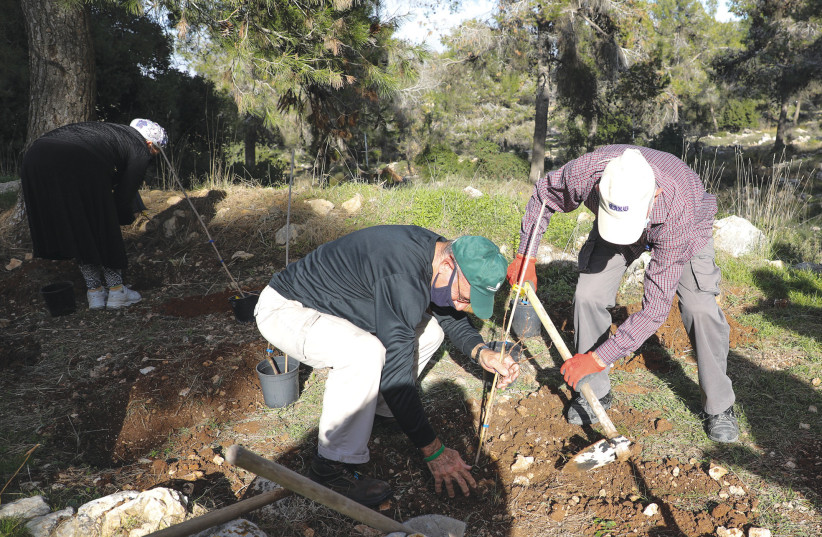Tu Bishvat: the time of year we wish a Happy Birthday to trees. For Jews the world over, especially Israeli Jews, Tu Bishvat, the fifteenth day of the Jewish month of Shvat, resonates.
It wasn’t always that way.
As a kid growing up in America, Tu Bishvat meant eating ugly-looking, dried out, impossible to bite, misshapen sticks called bokser, which I later learned was another way of saying carob. In those days, carob had not yet been embraced as a healthful alternative to chocolate.
Bokser was given to students in Jewish schools, in synagogues and to groups. We were told to eat it, so we did - or at least we tried to eat it. We were presented with enough for an entire family and because my father was our only family member who enjoyed it, I assumed bokser to be an adult taste, much like chopped liver or herring.
Fast forward to my adult years when I tasted bokser, aka carob, aka St. John’s Bread, in its fresh form. I thought I was eating something entirely different. How on earth anyone imagined that forcing children to eat a hard stick and call it a holiday still mystifies me. It was not a positive educational experience.

Over the past few days, I conducted an informal survey of people over the age of 50. I asked them what they remember of Tu Bishvat as a child. I asked New Yorkers and out-of-towners. I asked Europeans. Almost universally, the answer was the same – bokser. Always said with a grimace followed by a grin.
There are a few exceptions, but most people have a family tradition of eating dried fruits, fresh fruits, a fruit on which they could make the Shehechiyanu blessing, and nuts, traditionally fifteen in number to correspond to the fifteenth day of the month. Those people mostly comprise Israelis or the children of Israelis. Many of them also sing songs.
There is a reason for a discrepancy in family traditions and childhood memories. Tu Bishvat is one of several examples of how Judaism around the world has changed and been enriched by the creation of the Jewish state of Israel and the rise of Zionism.
Early Zionists embraced the idea of planting trees; they celebrated the reforestation of the land of Israel. Secular and religious Zionists alike glorified the land. They were “making the desert bloom.” Planting trees was a hands-on, realistic way of building the land. The entire mission of Keren Kayemet L’Yisrael - Jewish National Fund (KKL-JNF) was connected to the theme of tree planting – and to this day, it still is.
It should come as no surprise to learn that the cornerstones of major Israeli and Jewish institutions were laid on Tu Bishvat. The cornerstone for the Hebrew University of Jerusalem was laid on Tu Bishvat in 1918, the Technion – Israel Institute of Technology on Tu Bishvat in 1925 and the Knesset on Tu Bishvat of 1949 - the first Tu Bishvat after the creation of the state.
Tu Bishvat is a time for building Israel.
One of the reasons we were given petrified carob year after year as schoolchildren was because the carobs came from Israel and would not spoil in transit. As well, it was an opportunity to teach and retell the story of Honi Hame’agel, Honi the Circle Drawer, the Jewish Rip Van Winkle. Honi saw a man plant a carob tree for his grandchildren to one day enjoy, and promptly fell asleep after the planting. He awoke years later and saw the grandchildren of the man enjoying the fruit of the tree. And it was an opportunity to review the story of Shimon bar Yochai, also known as the revered Rashbi, and his son who were forced into hiding from the Romans and lived in a cave where they survived by eating carobs from a tree outside the cave.
Today, Tu Bishvat is much more than bokser, it is the Jewish Arbor Day. Jewish environmentalists embrace the day and all forms of Judaism have created Tu Bishvat Seders, replicating the custom of 15th-century kabbalists from Safed.
And the much-maligned bokser we ate as kids has an illustrious history. The word bokser comes from the German bokshornbaum: Baum means tree in German and bokshorn is a ram’s horn. The fruit of the tree is twisted like a ram’s horn, a shofar, hence the name. The name St. John’s Bread comes from a Christian story about how, much like Rashbi, John the Baptist subsisted on carobs.
The word carat, the term designating the weight of gemstones, and the word karat, the term designating the weight of gold, are derived from the word carob. The seeds of carobs are generally uniform in weight and they have been used for centuries as a standard against which to weigh things.
Planting trees in Israel was not an accident. Israel is one of the only countries in the world that began this century with more trees than in the previous century. Zionists were builders and planters. They were not just cutting down trees to build; they were planting to build.
They were reinvigorating an old tradition. The model for planting trees in Israel was created in 1887 by Rabbi Zev Yavitz who came to Israel and became the headmaster of the Rothschild School in Zichron Ya’acov. On Tu Bishvat in 1887, Yavitz took his entire student body out of school to plant trees. He later became one of the founders of Mizrachi, the religious Zionist movement, and the editor of HaMizrachi. A lover of the Hebrew language, Yavitz served on the language committee that institutes new Hebrew words. Two of his words are tarbut for culture and kvish for road. Today, every city in Israel has a kvish named Yavitz.
Tu Bishvat sameach! Have a happy – and significant – Tu Bishvat.
The writer is a columnist and social and political commentator.
